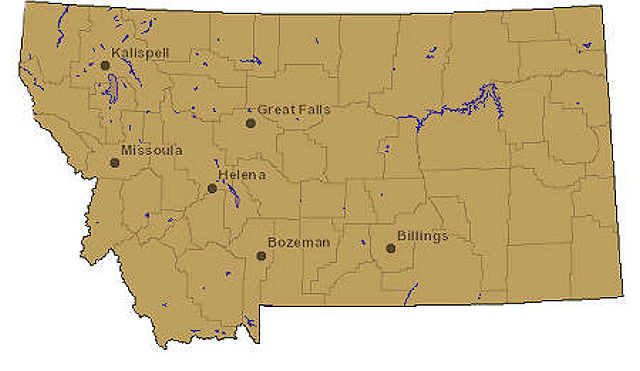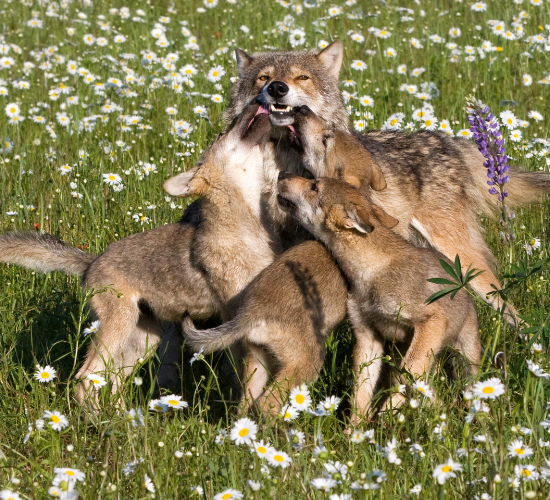Wolf

Canis lupis
Order: Carnivora
Family:
Canidae
Status: Wolves are managed in Montana in compliance with federal law and the state conservation and management plan. Montana maintains sustainable hunting and trapping harvest opportunities for wolves through regulated seasons.
Identifying Characteristics: Hair color variable even within populations; litter mates often express great variety. White, cream-colored, buff, tawny, reddish, gray, black, and mottled combinations thereof. All black wolves possible due to early hybridization with domestic dogs. Graying with age. The Gray Wolf is the largest of the wild dogs. About half the Gray Wolves in Montana are black with the other half gray. Both color phases may be found in a pack or in a litter of pups.
Total length: 70 to 73 inches. Weight: 80 to 110 pounds.
Habitat: Found living in forest, prairie, tundra, desert, and swamp; even living near or within large cities. Adapted to live across an extreme range of temperatures. The Gray Wolf exhibits no particular habitat preference except for the presence of native ungulates within its territory on a year-round basis. Gray Wolves establishing new packs in Montana have demonstrated greater tolerance of human presence and disturbance than previously thought characteristic of this species. They have established territories where prey are more abundant at lower elevations than expected, especially in winter.
Food Habits: Gray Wolves are opportunistic carnivores that predominantly prey on large ungulates. Main prey items include deer, Elk, and Moose. Bison are also taken where the ranges of the two species overlap in and around Yellowstone National Park. Domestic livestock such as cattle and sheep are also preyed upon. Gray Wolves may also eat alternative prey, such as rodents, vegetation and carrion. Gray Wolves commonly hunt in packs, but lone animals and pairs are able to kill prey as large as adult Moose.
Life History: Active day and night; remain with young pups during daylight hours. Travel alone late spring to summer; pack members form nomadic hunting groups late summer to early spring. Hunt within a cooperatively defended territory.
Similar Species: Coyote
 Ecology
Ecology
In most areas, Gray Wolves are territorial
throughout the year. Packs generally consist of
a socially dominant pair, their offspring of the
previous year, and new pups, although other
breeding-age adults that may or may not be
related to the alpha pair may also be present.
More than 1 female in the pack can breed and
give birth to pups. Pup survival when there are
multiple litters is highly variable. Pack size
varies and may include as few as 3 and as many
as 37. In the Glacier
National Park area, packs generally include 8 to
12 individuals. Packs
share pup-rearing responsibilities including
food provisioning and tending pups at the den or
rendezvous sites. Pack activity is
centered on the den site and nearby rendezvous
sites from late April until September. Lone Gray Wolves may move through
territories of established packs. Pack territories are dynamic and
change from year to year depending on prey
availability, Gray Wolf populations, and
relationships with neighboring packs.
Summer home ranges are smaller than winter
ranges; the annual range may be up to several
hundred square miles. In the Glacier
National Park area, territory size averages
around 300 square
miles. Gray Wolves may
occasionally move several hundred miles,
especially dispersing young.
 Life Cycle
Life Cycle
In Montana, Gray Wolves breed in mid- to late
February, with gestation lasting about 63 days.
A female can only give birth once a year.
Breeding usually occurs between the dominant
male and female in the pack and Gray Wolves
normally do not breed until they are at least 22
months old. More than 1 female in a pack may
breed, resulting in more than 1 litter per.
Young are typically born in late April in an
underground burrow that has been abandoned by
another mammal or dug by Gray Wolves. In
northwestern Montana litter sizes range from 1
to 9. Pups emerge from the den in about 3 weeks
and are weaned in about 50 days. Young vacate
the den when they are about 3 months old and
move to a series of rendezvous sites throughout
the pack's territory. The pups are large enough
to travel with the entire pack by September.
Some offspring remain with the pack and others
disperse as they mature. Lone Gray Wolves
generally do not successfully rear young, but
they may if food is abundant.
Pup
survival is variable and influenced by a number
of factors including disease, predation, and
nutrition. In Montana, pup mortality was most
often attributed to human causes, but canine
parvo virus was strongly suspected as a main
factor in low pup survival in Yellowstone.
Migration
This species is not migratory but may move
seasonally following migrating ungulates within
its territory. Gray Wolves also disperse widely.
Males in northwestern Montana can move an
average of 70 miles from their natal territory,
and females 48 miles, before establishing a new
territory or joining an existing pack. Dispersal
peaks twice per year; first in January/February
and second, in May/June. Some Gray Wolves are
known to have dispersed up to 500 miles.
Dispersal has been documented from Canada, Idaho
and Wyoming to Montana. Montana Gray Wolves are
also known to have dispersed to Canada, Idaho,
and Wyoming.
Background
The gray wolf was extirpated from the western
United States during the 1900s, primarily due to
loss of habitat and conflicts with people.
Although wolf packs were eliminated from
Montana by the 1930s, tracks, scat, and/or
observations of large canid-like animals were
either reported or those animals were killed up
until the 1970s. Most are thought to have been
dispersers from Canada and little to no
successful breeding activity was evidenced or
sustained consistently through time.
The
U.S. Fish and Wildlife Service listed the
northern Rocky Mountain gray wolf as endangered
under the Endangered Species Act in 1973.
In 1980, the Northern Rocky Mountain Wolf
Recovery Team completed a plan that would guide
wolf recovery efforts for a future wolf
population in the northern Rockies of Montana,
Idaho, and Wyoming. The recovery plan was
revised in 1987. The plan designated three
recovery areas - Northwestern Montana, Central
Idaho, and the Greater Yellowstone - each of
which included some portion of Montana.
Wolves from Canada began to naturally colonize
the Glacier National Park area in 1979, and the
first wolf den in the western U.S. in over 50
years was documented there in 1986. The wolf
population in northwest Montana grew as a result
of natural reproduction and dispersal. By the
end of 1994, there were about 48 wolves in and
around Glacier National Park.
In 1995,
three family groups - a total of 14 wolves -
were trapped captured near Alberta's Jasper
National Park, transported to Yellowstone
National Park, and placed in acclimation pens.
Two of the females subsequently denned and
produced nine pups in Montana.
Also in
the winter of 1995, 15 wolves were reintroduced
into the wilderness areas of central Idaho.
These animals moved widely throughout central
Idaho and beyond. Many of these wolves moved
north, some to the upper Bitterroot Valley. In
1996, three packs produced 11 pups.
In
the winter of 1996, 17 wolves were captured near
Fort St. Johns, British Columbia, Canada and
were again released into acclimation pens in
Yellowstone National Park. Twenty wolves were
released in central Idaho. These translocated
wolves were the same subspecies that existed in
the northern Rocky Mountains historically.
Wolves were not released within Montana, but
wolf populations in Yellowstone National Park
and central Idaho grew rapidly and soon became a
source for dispersers to Montana. New packs
formed outside the earliest core wolf areas and
overall wolf distribution expanded. Wolf
dispersal has been documented between and among
all three federal recovery areas and the states
comprising the northern Rockies.
By the
end of 2002, the northern Rockies wolf
population met the biological recovery criteria
of at least 30 breeding pairs in the northern
Rockies for three years in a row. By the end of
2004, there was an estimated 835 wolves and 66
breeding pairs in the tri-state area. In
Montana, there were about 153 wolves in 15
breeding pairs at that time.
Wolf
populations in the Northern Rocky Mountains
continued to expand and reached recovery goals.
With the exception of Wyoming, they were
delisted in 2011, giving management authority to
the states. The five-year federal oversight
period for Idaho and Montana ended in 2015 and
wolf populations remained well above minimum
federal management objectives of 15 breeding
pairs and 150 wolves in each state.
Management
While Montana has full authority to manage
wolves in the state, federal regulations
continue to guide management practices. To
remain in compliance with federal law, FWP’s
conservation and management program aims to
maintain the overall population high enough to
prevent its reclassification as threatened or
endangered under the Endangered Species Act.
Montana Fish,
Wildlife and Parks is the lead agency for Gray
Wolves, including population monitoring,
resolving wolf-livestock conflicts, research,
and public outreach. Federal regulations
continue to guide Montana Fish, Wildlife, and
Parks management practices.
Distribution and
Status
Wolves occur throughout Montana in the Rocky Mountain
range. They are managed and protected by
regulated harvest seasons.
Regulations Note
Before setting a wolf trap in Montana, a person
must successfully complete either a Montana FWP
or Idaho offered trapper education and
certification course. The Montana wolf trapper
education and certification courses are free and
open to individuals age 11 and older.